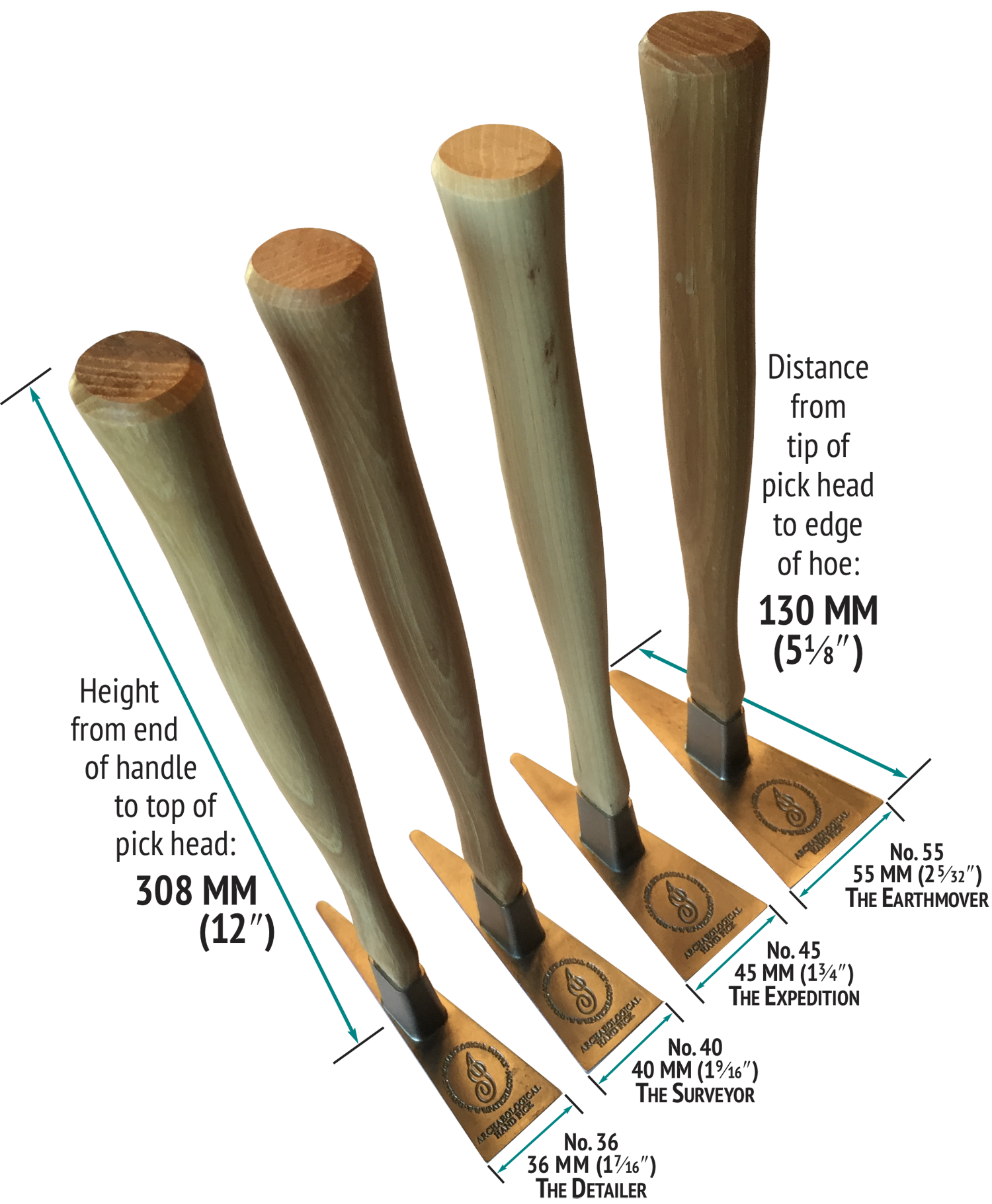Handpicks/Patiches
The lngalls Handpick/Patiche is a unique tool, designed for use by professional as well as amateur archaeologists, and built to last long enough to eventually show up in a dig as an artifact itself!
Four Sizes — Take Your Pick
To facilitate all aspects of excavation, the pick is available in four sizes:
The Detailer Handpick/Patiche
$184.62 + S&H
For careful work around emerging artifacts. Very narrow pick point (5mm, 3/16") and narrow hoe width (36mm, 1-7/16") for delicate earth removal. Not designed to meet high-efficiency dig site debris removal needs.
The Surveyor Handpick/Patiche
$184.62 + S&H
For general exploration as well as daily on-site use. The 40mm (1-9/16") hoe width and 6mm (1/4") pick point makes this tool suitable for daily dig site use and careful debris removal from around larger artifacts, rocks, stone blocks, etc.
The Expedition Handpick/Patiche
$184.62 + S&H
This pick is designed for long-term daily on-site production use. The 45mm (1-3/4") wide hoe and 7mm (9/32") pick point promotes efficient overburden removal without giving up the detailing advantages of a narrow pick point.
The Earthmover Handpick/Patiche
$184.62 + S&H
Too large for delicate work, but excellent where dig site preparation work is required to clear away large quantities of overburden. Hoe width is 55mm (2-5/32") with an 8mm (5/16") pick point for high-production debris removal.
Field Developed
Lightweight for easy use and transport, the current pick design is the result of years of gradual field development, primarily in the Mediterranean region and deserts of the Middle East. Careful consideration was given to how the handpick/patiche "feels" when used. The location of the rotational center point of the pick’s weight, in combination with the shape of the handle, help keep the handpick/patiche naturally balanced in your hand, making day-long use easier on your arm, shoulder and back.
The steel head of the pick is precisely formed from a thin-walled lost wax investment casting, resulting in a lightweight but durable unit. This sophisticated alloy material is the same tough, stain-resistant steel used in mountain climbing equipment. After the pick head is cast, it is heat-treated to hold an edge and to be hard enough to resist wearing out with use.
Special Digging Radius:
The pick head radius has its focal point at the handle grip/wrist pivot area to make cutting vertical balk walls easier. See #1 in photo
Deep Handle Shank:
An extra-deep internally reverse-tapered shank provides a simple, strong, solid, and secure handle-to-pick connection. See #2 in photo
Durable Quality Product:
High-quality pick heads are precision manufactured from a thin-walled lost wax investment casting. The stain-resistant steel alloy used for the pick’s construction is the same tough steel used in mountain climbing equipment where metal fatigue could mean death. After casting, the pick is heat-treated and tempered to maximize the hardness of the cutting edges. Designed to last a lifetime.
Hickory Handle:
Top-of-the-line 12" (305mm) adze eye hickory handle for an easy, slip-resistant grip. Shaped for maximum hand comfort. Best quality available, manufactured from hickory with a density of at least 48 pounds per cubic foot.
The wooden handle does not collect heat in the sun, preventing the “too hot to touch” syndrome. It is lighter than a handle made out of metal or one made out of metal and leather would be, as well as being easier to keep clean. Wood also helps to absorb the digging vibrations that can cause numbness of your hand after day-long usage. See #3 in photo
15° Beveled Sides:
Straight-edged 15° beveled sides allow for a natural hand angle when using the pick like a trowel to rake together loose rubble into a pile prior to removal. The beveled sides help keep the leading edge of the pick in contact with the ground, preventing the gathered material from “escaping” from under the moving pick. See #4 in photo


